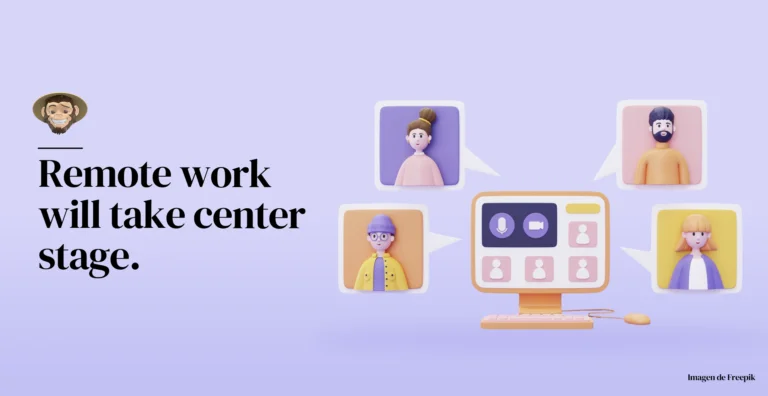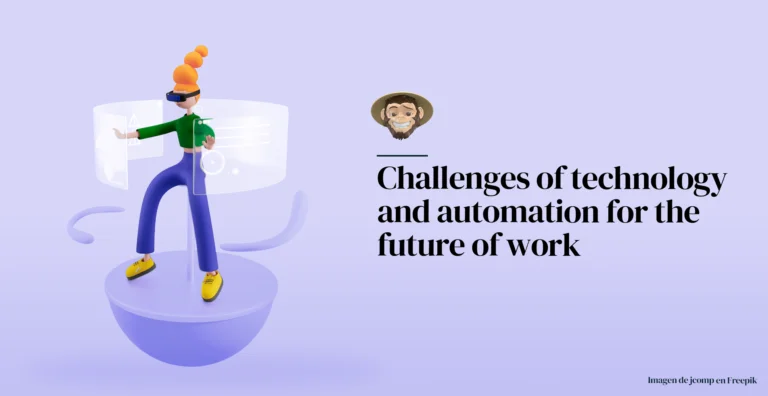Modern and upcoming technologies came to change and to shape the future of employment. Their widespread adoption has modified how we work, but how? Let’s see.
Have you ever stopped to think about how technology has changed our entire existence? It has not only introduced new ways to socialize, shop, work out, and even go to the doctor without stepping one foot outside. Technology has also become the all-encompassing force behind modern advancements such as Artificial Intelligence, robotics, and all other AI-powered tools, all of which have revolutionized countless industries and crafts and are even transforming how we work. Granted, it was mostly the pandemic hitting that caused businesses to be upended and had to modernize their work schemes in a matter of days. But still, the more technology evolved, the more we were starting to witness how technology and automation were playing an increasingly important role in shaping our working lives.
And now, as we move into the future, it’s clear that the more technology advances, the more reliant we’re on it to help us with our everyday tasks, which of course, includes the workplace. What’s more, with the evident rise of artificial intelligence, there has been significant growth in the use of automation in countless industries, such as healthcare, banking, education, manufacturing, and even entertainment, which has ignited a new need for increased efficiency and productivity. As a result, technology is undoubtedly changing how we work, and automation in our workplaces is slowly becoming the norm. But what does this mean for the future of work? How are technology and automation shaping the future of our workplaces? In this blog article, we’ll explore the impact of technology on our jobs, on how we perform them and highlight the trends and implications of this impact on individuals and businesses. Let’s begin.

The rise of AI will lead to significant workplace automation.
Yes, AI and automation aren’t exactly new and are certainly not “future trends” in the workplace; they are already making big waves left and right. However, as technology progresses rapidly, AI pushes its own limits and keeps finding new frontiers that bring us more innovative ways of leveraging its benefits. In fact, thanks to AI, automation has emerged and is rapidly blooming as a transformative force in the modern workplace that goes well beyond the traditional industrial automation we’re already familiar with. It has already started revolutionizing how some tasks are performed, modernizing workflows, and reshaping countless job roles, all of which, until a couple of years ago, relied solely on human labor.
For one, AI seems to be replacing humans in performing many mundane and repetitive tasks that traditionally have always required significant time and effort. One survey showed that over 40% of workers spend at least a quarter of their workweek on repetitive tasks. These tasks, such as data entry or packaging, for instance, although necessary in most workplace scenarios, often take too much time to perform manually, can lead to reduced job satisfaction, and limit creative and innovative outputs. So, by delegating these repetitive tasks to machines and software systems, companies can not only save time but also give employees a chance to focus on more practical, creative activities. As a result, we can expect to see increased efficiency, accuracy, creativity, innovation, and productivity, which will keep impacting various industries, contributing to economic growth and creating valuable opportunities for progress for workers and organizations alike.
Secondly, the automation of repetitive tasks will, without a doubt, create the need for companies to start upskilling and reskilling. Why? Because with mundane tasks being delegated to machines, humans who once performed those jobs will now have to focus on positions that demand complex problem-solving, critical thinking, creativity, and decision-making if they want to remain employable. As a result, they will need to either brush up on old skills or acquire new skills and knowledge to perform these higher-level jobs, which can range anywhere from learning programming languages to understanding project management and human resources or even gaining expertise in finances, emerging technologies, or management.
Lastly, while concerning for some, we must see this automation in the workplace brought on by AI as an opportunity for growth, development, and progress, especially on some societal and labor challenges. This collaboration between humans and machines isn’t simply a replacement for human workers; it is a way for us to leverage technology to enhance our capabilities, save priceless resources, and enhance our productivity.

We’ll see more productive workplaces.
Fact: Technology is the bringer of automation, and automation will always lead to increased productivity. And, as technology continues to advance and AI systems become even more efficient, human-like, and more intelligent, companies will be able to increase their productivity by:
Leveraging machine learning and AI algorithms for enhanced decision-making: Machine learning and AI algorithms now have the ability to read data and uncover patterns and pinpoint correlations hidden within said data. These insights, which the human eye may not readily identify, can help companies automate decision-making processes, optimize operations, make personalized recommendations, and assist workers in making more informed, accurate, and efficient choices.
Using predictive analytics more efficiently: Although nothing new, predictive analytics will arguably become the best way for organizations of any size to analyze historical data to make accurate predictions about future trends. This way, future decision-makers can leverage statistical models to anticipate customer behavior and market trends and even assess potential risks.
Leveraging AI for easier fraud detection: By simplifying and automating the data analysis process, businesses will be able to leverage AI and its offspring to uncover patterns, pinpoint anomalies, and use historical trends to identify security breaches or any other risks faster. As a result, future enterprises will proactively implement robust risk mitigation strategies instead of waiting for attacks to happen, thus ensuring the integrity of their data.
All in all, technology will keep making decision-making processes in the workplace more efficient and faster, leading to increased productivity by helping workers leverage the power of more robust data analytics powered by AI systems. At the same time, these systems will help decision-makers optimize operations, unlock valuable insights, and, more importantly, drive innovation, which will help them remain competitive and thrive in the digital age.

There will likely be visible economic and workforce growth.
Economic growth is the apparent by-product of both points exposed above. Modern technologies and automation, and the increased efficiency, innovation, and productivity increase they bring to the workplace; all play a pivotal role in shaping the economic growth of countless companies and industries. What’s more, technology has already opened up new and exciting avenues for businesses to not only enhance the efficiency of their operations but also to expand their reach globally with more ease and less human and monetary investment. But how?
For one, platforms such as e-commerce sites and applications, digital marketplaces, and mobile payment gateways and systems enable enterprises to showcase their products and services in a more efficient, attractive, and accessible way that goes beyond the traditional boundaries of physical storefronts and payment methods. As a result, businesses can now reach global market expansion in a more straightforward manner and promote digital commerce, which stimulates spending and cross-border trade and ultimately will turn into evident and substantial economic growth.
Secondly, while emerging technologies driven by AI and automation, among others, are on track to replace specific job roles that handle menial, repetitive tasks, the truth is that they may also open up avenues for new, more fulfilling, and valuable job opportunities that require advanced skills. Since technology, especially AI, will keep evolving and getting more sophisticated, the demand for professionals in fields such as data science, programming, app development, cybersecurity, and digital marketing will rise substantially. This transformation in the global workforce will not only drive future economic growth. Still, it may also result in governments and entities investing additional resources in education and upskilling programs for professionals of all areas. For instance, a study showed that AI and machine learning job roles rose by nearly 75% over the past four years. Another study by the World Economic Forum showed that AI should create around 97 million new jobs, which is undoubtedly more than enough to dispel any workforce displacement concerns. At any rate, these figures are indeed set to keep growing as newer, more advanced technologies and AI capabilities emerge.
So, technology and automation will keep taking center stage as critical drivers of economic growth in the modern workplace setting. They will also become a significant benchmark, leading the way for modern enterprises that want to innovate and remain competitive in the growing global economy of the future. And, as businesses see greater productivity, they will start delivering products and services that can better meet consumers’ expectations, leading to a better experience for them and which will ultimately lead to them spending more money.

Remote work will take center stage.
Last but not least, remote work. While its widespread use and popularity skyrocketed during the pandemic, with enterprises being forced to implement it in a matter of days, the truth is that remote work was already well on its way to becoming the norm for countless employees and companies around the globe. In fact, a study shows that around 30% of employees were already working remotely prior to the pandemic, a figure that, while dissent compared to the 50% post-pandemic remote workers, is still pretty darn impressive.
One of technology’s most valuable benefits is that it has facilitated remote and flexible working arrangements, which allow employees and business owners to work from their homes or anywhere they like and perform their functions without having to go to an office or commit to a set schedule. Furthermore, with the rise of more sophisticated meeting and collaboration tools, the birth of cloud computing, and the overall development of innovative virtual communication platforms, employees and teams will find better ways of staying in touch and collaborating seamlessly, even when geographically dispersed or on different time zones or schedules. This level of connectivity provided by technology that already exists helps bridge the physical distance between coworkers, facilitates engagement among remote teams, provides employees with increased flexibility, and helps them strike a healthy work-life balance.
Additionally, remote work will likely keep opening up opportunities for companies of all sizes to tap into a global talent pool more efficiently and hire competent workers regardless of their location, which is priceless to help businesses expand the access they currently have to valuable skill sets and expertise. As a result of this somewhat unlimited global talent acquisition and the benefits inherent to remote work, workers can find more fulfilling positions that save them commuting expenses and the hassle of moving to an office every day. Companies, on their part, will be able to further reduce overhead costs related to office space requirements, utility bills, and other costs can translate into substantial savings and overall better quality of life for both employee and employer.

Challenges of technology and automation for the future of work
As you can see, technology and automation offer numerous valuable benefits and opportunities to improve and optimize the future of work. Nonetheless, they also come with their fair share of challenges that we must keep an eye on and attempt to address as technology advances as they become more evident. Here are some of the main ones:
Job losses: As explained earlier, automation can replace specific tasks and job roles that rely on repetitive tasks, which creates concerns about job displacement. We believe technology will open avenues for more job positions in the future, but still, we need to reskill and upskill to remain relevant in a technology-driven work environment.
Embracing change: As technology and automation drive work evolution, there will be a paradigm shift where workers must embrace the increasingly important role of machines in the workplace. For some, however, this will not come easy. Some workers will need assistance adjusting to the new way of working and, in some cases, training and support so the machine-human relationship can flourish.
Workflow redesign: As workers must learn to work alongside machines, workflows, and workspaces must undergo a redesign process so they can be adapted to this new human-machine era and remain safe and productive.
Data security: Relying on technology will always bring forth data privacy and security concerns. And for the future of work, these concerns, which relate primarily to the collection and storage of vast amounts of personal and sensitive information, must be addressed, and we need to make sure we establish robust cybersecurity measures to protect individuals and organizations from data misuse.

As you can see, technology and automation are shaping the future of work in very meaningful, exciting ways. They are already starting to transform job roles and how we perform them through innovation and enhanced connectivity, which will lead to increased productivity levels, data-driven decision-making, better market relevance, and global market expansion. Moreover, technology and automation will keep creating better remote work opportunities by enhancing how we communicate and collaborate. This will help us create new opportunities for more fulfilling, valuable job positions.
So, by embracing technology and automation, accepting these changes with open arms, and proactively adapting to them, we’ll be able to leverage the undeniable benefits of innovation and thrive in the future tech-driven workplace. And, as technology shapes our global economy, it is essential for individuals and businesses to understand how to complement emerging technological advancements rather than compete against them.
We believe in the power of technology as a driver of progress and innovation. So, if you have any questions or want us to make your idea a reality, this article, please contact us!
